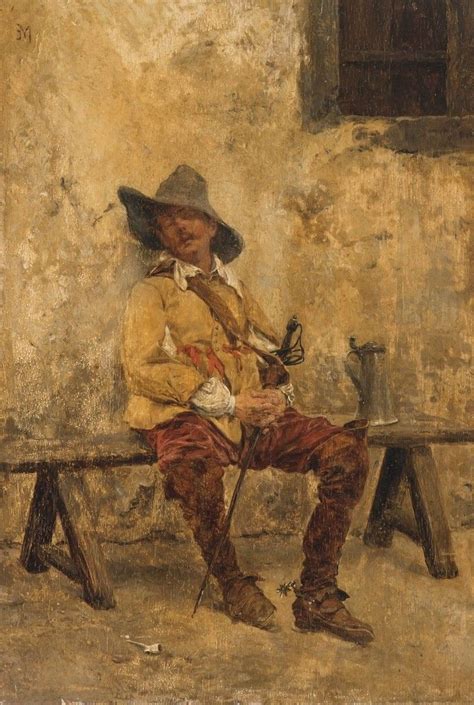Jean-Louis-Ernest Meissonier, one of the 19th century’s most celebrated French painters, remains revered for his meticulous attention to detail and his ability to evoke rich narratives within his small-scale works. Known primarily for his historical and military subjects, Meissonier’s painting “Midday Rest” stands out as an intimate portrayal of quiet reflection amid the rigors of life. Though diminutive in size, the oil-on-panel masterpiece encapsulates the essence of his artistic philosophy and technical prowess.
The Artist’s Legacy
Before diving into “Midday Rest,” understanding Meissonier’s legacy is essential. Born in Lyon, France, in 1815, Meissonier quickly rose to prominence during his lifetime. He gained acclaim for his ability to craft vivid, historically accurate depictions of military campaigns, often focusing on Napoleon’s conquests. Unlike many of his contemporaries, Meissonier eschewed grandiose, large-scale canvases in favor of intimate, smaller works that invited viewers to scrutinize every minute detail.
This focus on precision made him a pioneer of academic realism, a movement emphasizing exacting detail and lifelike representation. His works, while historical in subject, often carried universal themes—discipline, camaraderie, struggle, and, as in “Midday Rest,” the solace found in moments of respite.
Analysis of Midday Rest
“Midday Rest” is a testament to Meissonier’s ability to convey grandeur on a small scale. The composition is deceptively simple: a solitary figure, possibly a soldier or traveler, sits on a piece of earth, taking a break during a long journey. Yet, within this simplicity lies a wealth of detail and emotional depth that beckons closer examination.
The Figure
The central figure is dressed in historically accurate attire, suggesting Meissonier’s penchant for authenticity. Each fold of the fabric, every button on the coat, and the subtle interplay of light and backdrop on the figure’s garments reveal the painter’s dedication to realism. The relaxed posture of the subject conveys a sense of calm and introspection, contrasting sharply with the implied demands of the journey they’ve undertaken.
The figure’s face, though understated in its expression, hints at a deeper narrative. Is this a soldier pausing after a long march, a traveler reflecting on the road ahead, or simply someone savoring a fleeting moment of peace? Meissonier’s refusal to provide explicit answers invites viewers to project their interpretations onto the scene.
The Setting
The painting’s background is minimal yet evocative. A faint suggestion of the horizon line and muted earthy tones ground the figure in a rural, possibly barren landscape. The simplicity of the setting places full emphasis on the subject, aligning with Meissonier’s tendency to prioritize human emotion and experience over environmental grandeur.
The muted palette—dominated by shades of brown, beige, and gray—lends the painting a timeless quality. These colors not only enhance the mood of quietude but also mirror the earthy textures of the figure’s surroundings, further rooting them in their environment.
Themes of Reflection and Solitude
At its core, “Midday Rest” is a meditation on the necessity of rest and the beauty of solitude. In an era where many artists celebrated dramatic moments of history and heroism, Meissonier’s choice to focus on a quiet, unremarkable moment feels refreshingly human. This thematic choice reflects his broader artistic ethos: to find the extraordinary in the ordinary.
The painting’s title, “Midday Rest,” underscores the universality of the scene. Whether a soldier, a laborer, or a traveler, the need to pause and rejuvenate is a shared human experience. By capturing this moment, Meissonier elevates a mundane act to an enduring symbol of resilience and introspection.
Meissonier’s Technical Mastery
What truly sets “Midday Rest” apart is its technical execution. Meissonier’s unparalleled skill in rendering texture, light, and background is evident in every brushstroke. His use of light, in particular, deserves attention. The soft, diffused illumination suggests the subdued glow of midday, casting gentle shadows that enhance the three-dimensionality of the figure.
The level of detail in such a small work is staggering. Meissonier’s precision is especially apparent in the figure’s attire, where each stitch, crease, and fold is rendered with astonishing accuracy. This meticulousness was no accident; Meissonier often conducted extensive research, including the use of historical artifacts and live models, to ensure the authenticity of his work.
Despite his emphasis on detail, Meissonier never allowed his paintings to feel overly rigid or lifeless. In “Midday Rest,” the interplay of delicate textures and subtle tonal shifts creates a sense of warmth and vitality, drawing viewers into the scene.
Impression
Meissonier painted during a period of great upheaval and transformation in Europe. The 19th century witnessed the rise and fall of empires, revolutions, and the rapid industrialization of society. Amid these sweeping changes, Meissonier’s works often harkened back to earlier times, celebrating the resilience and fortitude of individuals in the face of adversity.
In “Midday Rest,” this historical lens is evident. While the specific time period of the painting is ambiguous, the subject’s attire and setting suggest a bygone era, evoking nostalgia for a simpler, perhaps more grounded way of life. This historical framing adds layers of meaning to the painting, inviting viewers to reflect on the endurance of human nature across generations.
The Enduring Appeal of Midday Rest
Since its creation, “Midday Rest” has continued to captivate art lovers and collectors. Its modest size and intimate subject matter make it an approachable work, yet its technical brilliance and emotional resonance ensure it leaves a lasting impression. In May 2017, the painting garnered attention at auction, further cementing its status as a cherished piece of art history.
What makes “Midday Rest” enduringly relevant is its universal appeal. In today’s fast-paced world, the painting’s themes of rest and reflection feel especially poignant. It serves as a gentle reminder to pause, breathe, and appreciate the quieter moments in life—lessons that resonate as much now as they did in Meissonier’s time.
As one of Meissonier’s many masterpieces, “Midday Rest” reaffirms his legacy as a pioneer of realism and a keen observer of the human condition. It remains a cherished work that continues to inspire and resonate with audiences worldwide.
No comments yet.








